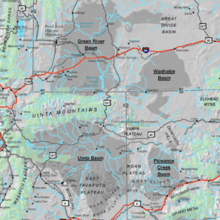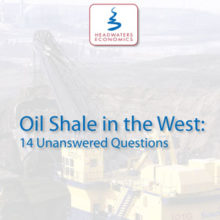For those wishing to dig deeper into the current politics and economics of oil shale, Headwaters Economics recommends the following sources. This is not a comprehensive list of oil shale publications or an endorsement of particular points of view, but rather a list of what we have found to be the most useful and up-to-date jumping off points from all sides of the debate. At the end of each entry, you will find a note as to the type of link we’ve recommended (web site or downloadable PDF) and its approximate publication date.
Background
Policy
Technology
Impacts
Industry
OIL SHALE BACKGROUND
Although somewhat dated, the RAND Corporation‘s overview, Oil Shale Development in the United States: Prospects and Policy Issues remains an excellent starting point. The report was prepared for the National Energy Technology Laboratory of the U.S. Department of Energy. (2005, PDF)
A more recent overview produced for the Department of Energy comes from the University of Utah’s Institute for Clean and Secure Energy. The Heavy Oil Program, which produced the report maintains a digital repository of oil shale resources which includes their report, A Technical, Economic, and Legal Assessment of North American Heavy Oil, Oil Sands, and Oil Shale Resources. (2007, web site and PDF)
The University of Colorado’s Center of the American West seeks to promote informed public dialogue on the development potential of oil shale. To this end, they have published an accessible overview of the resource’s past, present, and future, entitled What Every Westerner Should Know about Oil Shale. (2009, web site and PDF)
OIL SHALE POLICY
In reponse to directives from the (G.W.) Bush administration, the U.S. Department of Energy’s Office of Deputy Assistant Secretary for Petroleum Reserves convened a Task Force on America’s Unconventional Fuels. The reports from this process provide an overview of the case in favor of oil shale development from that administration’s perpsective. In addition to generic information on unconventional fuels, the Task Force’s web site offers links to its reports. (2004-present, web site)The Oil Shale and Tar Sands Programmatic EIS Information Center is the online center for public information and involvement in the Oil Shale and Tar Sands Programmatic Environmental Impact Statement (Oil Shale and Tar Sands PEIS), managed by the BLM with Argonne National Laboratory. The site contains links to the Programmatic EIS as well as information and resources. (2008-present, web site)
OIL SHALE TECHNOLOGY
The Office of Naval Petroleum and Oil Shale Reserves in the Department of Energy (DOE/NPOSR) has a mandate to provide current information on oil shale development to the federal government and also oversees dispensation of federal funding for oil shale research. They have recently published a useful overview of activity in oil shale research and development, entitled: Secure Fuels from Domestic Resources: The Continuing Evolution of America’s Oil Shale and Tar Shale Industries, Profiles of Companies Engaged in Domestic Oil Shale and Tar Sands Resource and Technology Development. (2009, PDF) The Center for Oil Shale Technology and Research (COSTAR) and the Colorado Energy Research Institute at the Colorado School of Mines convenes an annual conference on oil shale development, the most recent of which was held in October, 2009 Briefings from industry, Department of Energy, and academic experts on oil shale are delivered at the conference, the proceedings of which are available on the CERI web site. COSTAR is funded by three major oil companies, Total Exploration and Production, Shell Exploration and Production, and ExxonMobil Upstream Research Company.
IMPACTS OF OIL SHALE DEVELOPMENT
The Bureau of Land Management finalized a Programmatic Environmental Impact Statement for oil shale development in 2008. The agency, with Argonne National Laboratory, maintains a web site with access to the PEIS as well as general information about oil shale. (2008, web site)
In response to overwhelming impacts of the natural gas boom of the early 2000s, the Associated Governments of Northwest Colorado commissioned a report from BBC Research and Consulting of Denver, CO. The product, Northwest Colorado Socioeconomic Analysis and Forecasts is a comprehensive look at the socioeconomic impacts of current and projected growth in the energy industry in Northwest Colorado. Growth related to oil shale is modeled separately from that driven by conventional energy development. Concerns about resource availability prompted the State of Colorado to engage in an extensive planning exercise called Colorado Water for the 21st Century. The web site includes links to reports and briefings on issues facing the Yampa, White, and Green River watersheds, in which oil shale development in Colorado would occur. Western Resource Advocates, an environmental non-profit, recently conducted an extensive examination of the acquisition of water rights for oil shale and energy development in Northwest Colorado, Water on the Rocks, Oil Shale Water Rights in Colorado. (2009, web site) The country’s leading expert on greenhouse gas emissions from unconventional fuels is a Stanford University Assistant Professor Adam Brandt. His staff web page offers an overview of his published materials, as well as links to many of his publications on unconventional fuels. (2009, web site)
INDUSTRY INFORMATION
The National Oil Shale Association maintains a web site with a link to fact sheets and other materials. (2010, web site)



